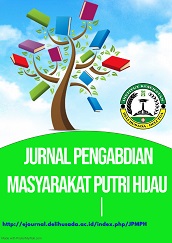PENYULUHAN TENTANG DAUN ANTING ANTING SEBAGAI PENGOBATAN DIARE DIDESA BIRU BIRU
Abstract
The lecture on the efficacy of Leaf Earrings as a treatment for diarrhea in Biru-biru Village is intended to reflect on, create and apply the information and progress that has been considered by students in conversation with the wider area. To find out how to deal with Earring Leaves so that its properties can be used as an intestinal relaxant that is good for the body, it's good to know in advance the existence of Earring Leaves so that people know the benefits of Earring Leaves.
In this expansion, there are three stages used in its implementation, namely: Inviting members with notification to the local area in Biru-biru Village, Input which is the most common way of preparing, then, at that time, Evaluating the Results of the Training by knowing the estimated effect aside from preparation. The PKM assessment is still being carried out. The PKM respect is obtained from several standards that have been regulated in the PKM regulations, with this principle the creators are interested in coordinating guidance on earring leaves as a treatment for diarrhea in the people of Biru-biru Village. So this investigation is based on the greatness of the creator. Earring leaves have many benefits in traditional medicine. Where in different studies it causes this hoop leaf plant to have an impact or movement, for example for stiffness and lowering uric acid. The hoop plant is used by the local area to correct enzema, uterine death, skin irritation. Acalypha indica can also be used to treat diabetes mellitus. It is believed that in this lecture the Efficacy of Earring Leaves can have a good effect on the treatment of diarrhea. Then counseling was carried out to find out the benefits and content contained in the Earring Leaves through several methods that support this counseling.
References
Alan, Miller, N.D., 2016, Antioxidant flavonoid structural usage alternative medical 103-111.
Arisandi Y. 2008. Khasiat Tanaman Obat. Jakarta: Pustaka Buku Merah.
Bruneton Jean. 2016. Alkaloids. In H.K. Caroline : Pharmacognosy : phytochemistry and medicinal plants. 2nd ed. Paris : Lavoisier publishing. p. 217-220.
Dalimartha, S., & Adrian, F. (2011). Khasiat buah & sayur. Jakarta: Penebar Swadaya.
Departemen Kesehatan RI. Profil Kesehatan Indonesia 2015. Jakarta: Departemen Kesehatan RI; 2016.
Duke, J.A. 2010. Handbook of Medical Herbs, Second Edition, ISBN: 978-0849312847 CRC Press LLC, 359
Ganong WF (2015). Review of Medical Physiology Ganong’s. 23rd edition. New York: The McGraw-Hill Companies.Inc. pp: 609-610
Haidari, F., Keshavarz, S. A., Rashidi, M. R. & Shahi, M. M., 2009, Orange Juice
and Hesperetin Supplementation to Hyperuricemic Rats Alter Oxidative
StressMarkersandXanthineOxidoreductaseActivity,J.Clin.Biochem. Nutr., 45 (3), 285-291.
Heyne, K.,2017,Tumbuhan Berguna Indonesia, Volume II, Yayasan Sarana Wana Jaya : Diedarkan oleh Koperasi Karyawan, Badan Litbang Kehutanan, Jakarta.
Ngastiyah, 2015, Perawatan Anak Sakit, Penerbit Buku Kedokteran EGC, Jakarta.
Suraatmaja S. Kapita selekta Gastroentrologi. Jakarta: Sagung Seto; 2017.
Suriadi & Yuliana, Rita. 2016. Asuhan Keperawatan Pada Anak. Jakarta : Sagung seto.
WHO. World Health Statistics 2015: World Health Organization; 2015.
Wijayakusuma, 2000, Tumbuhan Berkhasiat Obat Indonesia, Jilid I, Penerbit Pustaka
Kartini, Jakarta.












